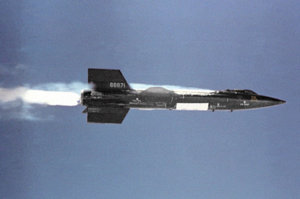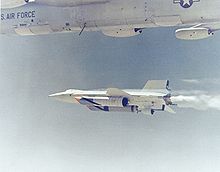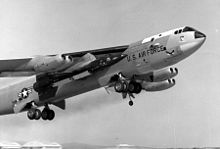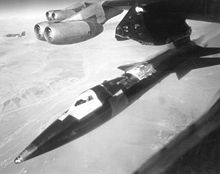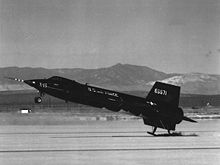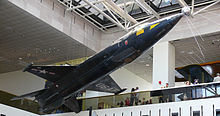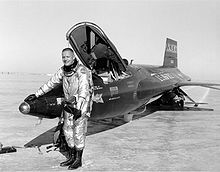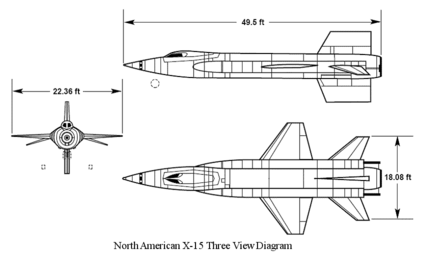- North American X-15
-
X-15 Role Experimental high-speed rocket-powered research aircraft Manufacturer North American Aviation First flight 8 June 1959 Introduction 17 September 1959 Retired December 1970 Primary users United States Air Force
NASANumber built 3 The North American X-15 rocket-powered aircraft/spaceplane was part of the X-series of experimental aircraft, initiated with the Bell X-1, that were made for the USAAF/USAF, NACA/NASA, and the USN. The X-15 set speed and altitude records in the early 1960s, reaching the edge of outer space and returning with valuable data used in aircraft and spacecraft design. As of 2011[update], it holds the official world record for the fastest speed ever reached by a manned rocket-powered aircraft.[1]
During the X-15 program, 13 of the flights (by eight pilots) met the USAF spaceflight criteria by exceeding the altitude of 50 miles (80 km) thus qualifying the pilots for astronaut status. The USAF pilots qualified for USAF astronaut wings, while the civilian pilots were later awarded NASA astronaut wings.[2][3]
Of all the X-15 missions, two flights (by the same pilot) qualified as space flights per the international (Fédération Aéronautique Internationale) definition of a spaceflight by exceeding 100 kilometers (62.1 mi, 328,084 ft) in altitude.
Contents
Design and development
The X-15 was based on a concept study from Walter Dornberger for the NACA for a hypersonic research aircraft.[4] The requests for proposal were published on 30 December 1954 for the airframe and on 4 February 1955 for the rocket engine. The X-15 was built by two manufacturers: North American Aviation was contracted for the airframe in November 1955, and Reaction Motors was contracted for building the engines in 1956.
Like many X- series aircraft, the X-15 was designed to be carried aloft, under the wing of a NASA B-52 mother ship, the Balls 8. Release took place at an altitude of about 8.5 miles (13.7 km) and a speed of about 805 kilometers per hour (500 mph).[5] The X-15 fuselage was long and cylindrical, with rear fairings that flattened its appearance, and thick, dorsal and ventral wedge-fin stabilizers. Parts of the fuselage were heat-resistant nickel alloy (Inconel-X 750).[4] The retractable landing gear comprised a nose-wheel carriage and two rear skis. The skis did not extend beyond the ventral fin, which required the pilot to jettison the lower fin (fitted with a parachute) just before landing.
Cockpit and pilot systems
The X-15 was a research aircraft, and there were changes to it over the course of the program and between the different airframes. The X-15 had to be operated under several different situations including the time attached to a carrier aircraft, drop, main engine start and acceleration, a ballistic flight into thin air/space, re-entry into thicker air, and an unpowered glide to landing. Alternatively, if the main engine was not started the pilot needed to go directly to a landing. The main rocket engine only operated for a relatively short part of the flight, but was capable of boosting the X-15 to its high-speeds and altitudes. The X-15's instruments and control surfaces were not unpowered without the main engine, its just that it could not maintain altitude.
The X-15 had multiple control systems for the pilot, including a traditional rudder and stick, but also another joystick on the left which gave commands to the reaction control system (RCS).[6] There was yet another joystick on the right for use during high G maneuvers that augmented the center stick.[6] The X-15 also had a "Stability Augmentation System" (SAS) which gave extra inputs to the aerodynamic controls to help the pilot maintain control.[6] The reaction control system could be operated in two modes: manual and automatic.[7] The automatic mode used a feature called "Reaction Augmentation System" (RAS) that helped stabilize the vehicle during high altitudes.[7] The RAS was typically used for around three minutes of a X-15 flight before being automatically turned off.[7] The X-15 actually had two different types of controls, one type was just discussed and was used on airframe 1 and 2, and another on airframe 3.[7] Airframe 3 had the MH-96 flight control systems, allowing one joystick in place of three and allowing simpler pilot inputs over the course of a flight.[8]
Among the many other controls, were the rocket engine throttle and a control for ejecting the bottom tail fin.[6] Another feature of the cockpit were heated windows to prevent icing, and a forward headrest for periods of high de-accleration.[6]
The X-15 had an ejection seat that allowed ejection at speeds up to Mach 4 and/or 120,000 feet (~36.6 km) altitude, although it was not used during the program.[6] In the event of ejection, the seat had deployable fins which were used until it reached a safer speed/altitude, where it could deploy its main parachute.[6] Pilots wore a pressure suit, pressurized with nitrogen gas.[6] Above 35,000 ft (~10.7 km) altitude, the cockpit was pressurized to 3.5 psi with nitrogen gas, and oxygen for breathing was fed separately to the pilot.[6]
Engines and fuel
Early flights used two Reaction Motors XLR11 engines. Later flights were undertaken with a single Reaction Motors Inc XLR99 rocket engine generating 57,000 pounds-force (250 kN) of thrust that powered the aircraft. This engine used ammonia and liquid oxygen for propellant and hydrogen peroxide to drive the high-speed turbopump that delivered fuel to the engine.[9] The XLR99s could be throttled, and were the first such controllable engines that were man-rated.[disputed ]
The XLR11 used ethyl alcohol and liquid oxygen, and the XLR99 used ammonia and liquid oxygen as fuel. The X-15 reaction control system (RCS), for maneuvering in low-pressure, used hydrogen peroxide as a monopropellant.[7] It is actually high-test peroxide, and it decomposes into water and oxygen in the presence of a catalyst, and can give an ISP of 140 seconds.[10] The HTP also powered a turbopump for the main engines and auxiliary power units (APUs).[9] Additional tanks for helium and liquid nitrogen performed other functions, for example the fuselage interior was purged with helium gas and the liquid nitrogen was used as coolant for various systems.[9]
Wedge tail and hypersonic stability
The X-15 had a thick wedge tail for stability at hypersonic speeds.[11] However, this produced a lot of drag at slower speeds.[11] In fact, the blunt end of the X-15 could produce as much drag as an entire F-104 Starfighter.[11]
A wedge shape was used because it is more effective than the conventional tail as a stabilizing surface at hypersonic speeds. A vertical-tail area equal to 60 percent of the wing area was required to give the X-15 adequate directional stability.
— Wendell H. Stillwell, X-15 Research Results (SP-60)
Additionally, stability at hypersonic speeds was aided by side panels that could extend out from the tail to further increase area, and these panels doubled as air-brakes.[11]
Operational history
Three X-15s were built, flying 199 test flights, the last on 24 October 1968. The first X-15 flight was an unpowered test flight by Scott Crossfield, on 8 June 1959; he also piloted the first powered flight, on 17 September 1959, with his first XLR-99 flight on 15 November 1960. Twelve test pilots flew the X-15; among them were Neil Armstrong (first man to walk on the moon) and Joe Engle (later a space shuttle commander). In July and August 1963, pilot Joe Walker crossed the 100 km altitude mark, joining the NASA astronauts and Soviet Cosmonauts as the first humans to have crossed the barrier into outer space.
On 15 November 1967, U.S. Air Force test pilot Major Michael J. Adams was killed on X-15 Flight 191 when the (X-15-3) entered a hypersonic spin while descending, then oscillated violently as aerodynamic forces increased after re-entry. As his aircraft's flight control system operated the control surfaces to their limits, acceleration built to 15 g vertical and 8 g lateral. The airframe broke apart at 60,000 ft (18,000 m) altitude, scattering the X-15's wreckage for 50 square miles (130 km2). On 8 June 2004, a monument was erected at the cockpit's locale, near Randsburg, California.[12] Major Adams was posthumously awarded Air Force astronaut wings for his final flight in X-15-3, which had reached 81.1 km (50.4 mi, 266,000 ft) of altitude. In 1991, his name was added to the Astronaut Memorial.
The second X-15A was rebuilt after a landing accident. It was lengthened 2.4 feet (0.73 m), a pair of auxiliary fuel tanks attached under the fuselage, and a heat-resistant surface treatment applied. Re-named the X-15A-2, it first flew on 28 June 1964, reaching 7,274 km/h (4,520 mph, 2,021 m/s).
The altitudes attained by the X-15 aircraft do not match that of Alan Shepard's 1961 NASA space capsule flight nor subsequent NASA space capsules and space shuttle flights. However, the X-15 flights did reign supreme among rocket-powered aircraft until the second spaceflight of Space Ship One in 2004.
Five aircraft were used for the X-15 program: three X-15s, two B-52 bombers:
- X-15A-1 – 56-6670, 82 powered flights
- X-15A-2 – 56-6671, 53 powered flights
- X-15A-3 – 56-6672, 64 powered flights
- NB-52A – 52-003 (retired in October 1969)
- NB-52B – 52-008 (retired in November 2004)
A 200th flight over Nevada was slated for 21 November 1968, piloted by William J. Knight. Technical problems and bad weather delayed the flight six times, and on 20 December 1968, the 200th flight was finally canceled. The X-15 was detached from the NB-52A wing and prepared for indefinite storage.
Current static displays
- X-15-1 (AF Ser. No. 56-6670) is on display in the National Air and Space Museum "Milestones of Flight" gallery, Washington, D.C.
- X-15-2A (AF Ser. No. 56-6671) is at the National Museum of the United States Air Force, at Wright-Patterson Air Force Base, near Dayton, Ohio. It was retired to the Museum in October 1969.[13] The aircraft is displayed in the Museum's Research & Development Hangar alongside other "X-planes", including the Bell X-1B and Douglas X-3 Stiletto.
- X-15-3 (AF Ser. No. 56-6672) was destroyed during X-15 Flight 191. Parts from this aircraft have been recovered at the crash site as late as the 1990s.
Mock-ups
- Dryden Flight Research Center, Edwards AFB, California, USA (painted with AF Ser. No. 56-6672)
- Pima Air Museum, Tucson, Arizona (painted with AF Ser. No. 56-6671)
- Evergreen Aviation Museum, McMinnville, Oregon (painted with AF Ser. No. 56-6672). A full-scale wooden mock-up of the X-15, it is displayed along with one of the rocket motors.
Stratofortress mother ships
- NB-52A (AF Ser. No. 52-003) is displayed at the Pima Air and Space Museum adjacent to Davis-Monthan AFB in Tucson, Arizona. It launched the X-15-1 30 times, the X-15-2A, 11 times, and the X-15-3 31 times (as well as the M2-F2 four times, the HL-10 11 times and the X-24A twice).
- NB-52B (AF Ser. No. 52-008) is displayed at the Dryden Flight Research Center at Edwards AFB, California. It launched the majority of X-15 flights.
X-15 orbital launch system proposals
Before 1958, USAF and NACA, (later NASA), officials discussed an orbital X-15 spacecraft, the X-15B for launching to outer space atop an SM-64 Navajo missile. This was canceled when NACA became NASA, and Project Mercury was approved instead. By 1959, the Boeing X-20 Dyna-Soar space-glider program became the USAF's preferred means for launching military manned spacecraft into orbit; however, this program was canceled in the early 1960s before an operational vehicle could be built.[2] Various configurations of the Navajo were considered, and another proposal proposed a Titan I stage.[14]
In a 1962 proposal, the B-15/X-15 combination was modified so the X-15 was the middle stage in a space launch system sending a Blue Scout rocket into space.[14] The Blue Scout was launched from the X-15 after it was dropped by the NB-52.[14]
Record flights
Highest flights
There are two definitions of how high a person must go to be referred to as an astronaut. The USAF decided to award astronaut wings to anyone who achieved an altitude of 50 miles (80 km) (80.5 km) or more. However, the FAI set the limit of space at 100 kilometers (62.1 mi). Thirteen X-15 flights went higher than 50 miles (80 km) and two of these reached over 100 kilometers.
X-15 flights higher than 50 mi (80 km) Flight Date Top speed Altitude Pilot Flight 62 17 July 1962 3,831 mph (6,165 km/h) 59.6 miles (95.9 km) Robert M. White Flight 77 17 January 1963 3,677 mph (5,918 km/h) 51.4 miles (82.7 km) Joe Walker Flight 87 27 June 1963 3,425 mph (5,512 km/h) 53.9 miles (86.7 km) Robert Rushworth Flight 90 19 July 1963 3,710 mph (5,970 km/h) 65.8 miles (105.9 km) Joe Walker Flight 91 22 August 1963 3,794 mph (6,106 km/h) 67.0 miles (107.8 km) Joe Walker Flight 138 29 June 1965 3,431 mph (5,522 km/h) 53.1 miles (85.5 km) Joe H. Engle Flight 143 10 August 1965 3,549 mph (5,712 km/h) 51.3 miles (82.6 km) Joe H. Engle Flight 150 28 September 1965 3,731 mph (6,004 km/h) 55.9 miles (90.0 km) John B. McKay Flight 153 14 October 1965 3,554 mph (5,720 km/h) 50.4 miles (81.1 km) Joe H. Engle Flight 174 1 November 1966 3,750 mph (6,040 km/h) 58.1 miles (93.5 km) Bill Dana Flight 190 17 October 1967 3,856 mph (6,206 km/h) 53.1 miles (85.5 km) Pete Knight Flight 191 15 November 1967 3,569 mph (5,744 km/h) 50.3 miles (81.0 km) Michael J. Adams† Flight 197 21 August 1968 3,443 mph (5,541 km/h) 50.6 miles (81.4 km) Bill Dana † fatal
Fastest flights
X-15 10 fastest flights Flight Date Top Speed Altitude Pilot Flight 45 9 November 1961 4,092 mph (6,585 km/h) 19.2 miles (30.9 km) Robert M. White Flight 59 27 June 1962 4,104 mph (6,605 km/h) 23.4 miles (37.7 km) Joe Walker Flight 64 26 July 1962 3,989 mph (6,420 km/h) 18.7 miles (30.1 km) Neil Armstrong Flight 86 25 June 1963 3,910 mph (6,290 km/h) 21.7 miles (34.9 km) Joe Walker Flight 89 18 July 1963 3,925 mph (6,317 km/h) 19.8 miles (31.9 km) Robert Rushworth Flight 97 5 December 1963 4,017 mph (6,465 km/h) 19.1 miles (30.7 km) Robert Rushworth Flight 105 29 April 1964 3,905 mph (6,284 km/h) 19.2 miles (30.9 km) Robert Rushworth Flight 137 22 June 1965 3,938 mph (6,338 km/h) 29.5 miles (47.5 km) John B. McKay Flight 175 18 November 1966 4,250 mph (6,840 km/h) 18.7 miles (30.1 km) Pete Knight Flight 188 3 October 1967 4,519 mph (7,273 km/h) 19.3 miles (31.1 km) Pete Knight X-15 pilots
X-15 pilots and their achievements during the program Pilot Organization Total
FlightsUSAF
space
flightsFAI
space
flightsMax
MachMax
speed
(mph)Max
altitude
(miles)Michael J. Adams† U.S. Air Force 7 1 0 5.59 3,822 50.3 Neil Armstrong NASA 7 0 0 5.74 3,989 39.2 Scott Crossfield North American Aviation 14 0 0 2.97 1,959 15.3 Bill Dana NASA 16 2 0 5.53 3,897 58.1 Joe H. Engle U.S. Air Force 16 3 0 5.71 3,887 53.1 Pete Knight U.S. Air Force 16 1 0 6.70 4,519 53.1 John B. McKay NASA 29 1 0 5.65 3,863 55.9 Forrest S. Petersen U.S. Navy 5 0 0 5.3 3,600 19.2 Robert A. Rushworth U.S. Air Force 34 1 0 6.06 4,017 53.9 Milt Thompson NASA 14 0 0 5.48 3,723 40.5 Joe Walker U.S. Air Force 25 3 2 5.92 4,104 67.0 Robert M. White* U.S. Air Force 16 1 0 6.04 4,092 59.6 † Killed • * White was backup for Captain Iven Kincheloe Specifications (X-15)
General characteristics
- Crew: one
- Length: 50 ft 9 in (15.45 m)
- Wingspan: 22 ft 4 in (6.8 m)
- Height: 13 ft 6 in (4.12 m)
- Wing area: 200 ft2 (18.6 m2)
- Empty weight: 14,600 lb (6,620 kg)
- Loaded weight: 34,000 lb (15,420 kg)
- Max takeoff weight: 34,000 lb (15,420 kg)
- Powerplant: 1 × Thiokol XLR99-RM-2 liquid-fuel rocket engine, 70,400 lbf at 30 km (313 kN)
Performance
- Maximum speed: Mach 6.72 (4,520 mph, 7,274 km/h)
- Range: 280 mi (450 km)
- Service ceiling: 67 mi (108 km, 354,330 ft)
- Rate of climb: 60,000 ft/min (18,288 m/min)
- Wing loading: 170 lb/ft2 (829 kg/m2)
- Thrust/weight: 2.07
See also
- Aircraft of comparable role, configuration and era
- Related lists
- List of rocket planes
- List of X-15 flights
- List of space disasters
References
- Notes
- ^ Aircraft Museum X-15." Aerospaceweb.org, 24 November 2008.
- ^ a b Jenkins 2001, p. 10.
- ^ "NASA astronaut wings award ceremony". NASA Press Release, 23 August 2005.
- ^ a b Käsmann 1999, p. 105.
- ^ "X-15 launch from B-52 mothership." Dryden Flight Research Center Photo Collection. Retrieved: 8 February 2011.
- ^ a b c d e f g h i Raveling, Paul. "X-15 Pilot Report, Part 2: X-15 Cockpit Check." SierraFoot. Retrieved: 1 October 2011.
- ^ a b c d e Jarvis, Calvin R. and Wilton P. Lock. "Operational Experience With the X-15 Reaction Control and Reaction Augmentation Systems." NASA, TN D-2864, 1965.
- ^ "Forty Years ago in the X-15 Flight Test Program, November 1961–March 1962." Goleta Air & Space Museum. Retrieved: 3 October 2011.
- ^ a b c Raveling, Paul. "X-15 Pilot Report, Part 1: X-15 General Description & Walkaround." SierraFoot. Retrieved: 30 September 2011.
- ^ Davies 2003, p. 8.28.
- ^ a b c d Wendell H. Stillwell - X-15 Research Results With a Selected Bibliography (NASA SP-60, 1965)
- ^ "X-15A Crash site." 'check-six.com, 1 July 2011. Retrieved: 30 September 2011.
- ^ United States Air Force Museum 1975, p. 73.
- ^ a b c "X-15/Blue Scout." Encyclopedia Astronautica. Retrieved: 30 September 2011.
- Bibliography
- "SP-2000-4531: American X-Vehicles: An Inventory X-1 to X-50." NASA, June 2003.
- Davies, Mark. The Standard Handbook for Aeronautical and Astronautical Engineers. New York: McGraw-Hill Professional, 2003, First edition 2002. ISBN 978-0071362290.
- "Flight experience with shock impingement and interference heating on the X-15-2 research airplane 1968." NASA.
- Godwin, Robert, ed. X-15: The NASA Mission Reports. Burlington, Ontario: Apogee Books, 2001. ISBN 1-896522-65-3.
- Hallion, Dr. Richard P. "Saga of the Rocket Ships." AirEnthusiast Six, March–June 1978. Bromley, Kent, UK: Pilot Press Ltd.
- Jenkins, Dennis R. Space Shuttle: The History of the National Space Transportation System: The First 100 Missions, 3rd edition. Stillwater, Minnesota: Voyageur Press, 2001. ISBN 0-9633974-5-1.
- Käsmann, Ferdinand C.W. "Die schnellsten Jets der Welt". Weltrekord-Flugzeuge [World Speed Record Aircraft] (in German). Kolpingring, Germany: Aviatic Verlag, 1999. ISBN 3-925505-26-1.
- "Thermal protection system X-15A-2 Design report." NASA report 1968 (PDF format).
- Thompson, Milton O. and Neil Armstrong. At the Edge of Space: The X-15 Flight Program. Washington, DC: Smithsonian Institution Press, 1992. ISBN 1-56098-107-5.
- Tregaskis, Richard. X-15 Diary: The Story of America's First Space Ship. Lincoln, Nebraska: iUniverse.com, 2000. ISBN 0-595-00250-1.
- United States Air Force Museum Guidebook. Wright-Patterson AFB, Ohio: Air Force Museum Foundation, 1975.
- "X-15 research results with a selected bibliography." NASA report (PDF format).
- "X-15: Extending the Frontiers of Flight." NASA (PDF format).
External links
- NASA
- NASA's X-15 website
- X-15 Research Results With a Selected Bibliography (NASA SP-60, 1965)
- "Transiting from Air to Space: The North American X-15" (1998)
- "Proceedings of the X-15 First Flight 30th Anniversary Celebration, 8 June 1989"
- (PDF) Hypersonics Before the Shuttle: A Concise History of the X-15 Research Airplane (NASA SP-2000-4518, 2000)
- Interview with Neil Armstrong about his experience in the X-15
- X-15 Hypersonic Research Program (12.15.09)
- X-15 photos at Dryden
- X-15 movies at Dryden
- Interactive X-15 portal by NASA (uses Macromedia Flash)
- Non-NASA
- A Field Guide to American Spacecraft - Locations of X-15 aircraft
- unofficial X-15 website
- Encyclopedia Astronautica's X-15 chronology
- Major Michael Adams Monument
- X15 site in French, with detailed flight reports
- Aerospace Legacy Foundation
- X-15, X-15A-2 • Dimensional references, plans and images (Primary source: NASA Technical Reports)
- X-15 at the Internet Movie Database
USAF/Joint Service experimental aircraft designations 1941– (X-planes) 1–25 26–50 50- X-51 · (X-52 not assigned) · X-53 · X-54 · X-55
United States human spaceflight programs Active ISS (joint)

Previous X-15 (suborbital) · Mercury · Gemini · Apollo · Skylab · Apollo-Soyuz (with USSR) · Space Shuttle · Shuttle-Mir (with Russia)
Canceled Lists relating to aviation General Aircraft (manufacturers) · Aircraft engines (manufacturers) · Airlines (defunct) · Airports · Civil authorities · Museums · Registration prefixes · Rotorcraft (manufacturers) · TimelineMilitary Accidents/incidents Records Categories:- 1963 in spaceflight
- Manned spacecraft
- Rocket-powered aircraft
- Spaceplanes
- X-15 program
- Parasite aircraft
- United States experimental aircraft 1950–1959
- Reusable space launch systems
- North American Aviation aircraft
- High-test peroxide
- Air launch to orbit
- Hypersonic aircraft
Wikimedia Foundation. 2010.

